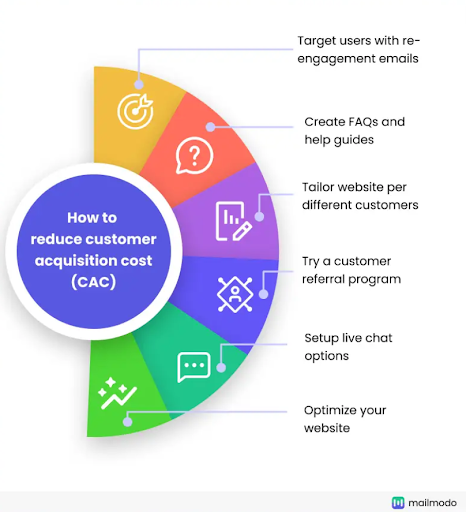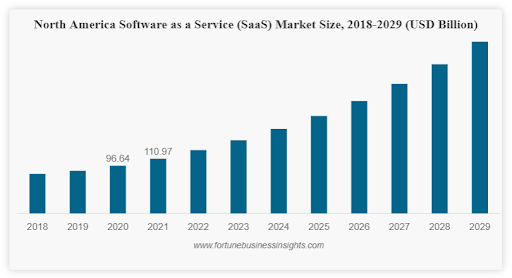The B2B SaaS market has experienced exponential growth in recent years. Valued at $215 billion in 2021, the global SaaS market size is expected to grow to $883 billion by 2029.
The incredible growth of the B2B SaaS market can be attributed to the increasing adoption of cloud computing, digital transformation, and the rise of remote work. However, that is also causing the market to become more competitive, making it crucial for B2B SaaS companies to find the balance between profit and growth to succeed.
If your business is growing rapidly but not making enough profit, you will not be able to sustain it for long. Similarly, if you focus only on profitability, you may not be open to innovation, hindering long-term growth.
In this blog post, we’ll explore some strategies for finding the right balance between profit and growth in the B2B SaaS world.
Best Strategies for B2B SaaS Companies to Balance Profit and Growth
To find the right balance between profit and growth, B2B SaaS companies need to develop a scalable business model to generate revenue growth while maintaining profitability.
Here are some effective strategies to do so.
Prioritize Operational Efficiency
Increasing operational efficiency and cost control can help B2B SaaS companies achieve business growth while being profitable at the same time. This includes automating tasks, streamlining internal processes, and reducing unnecessary expenses.
Technology can be immensely helpful in increasing operational efficiency. Depending on your business needs, you may want to invest in different tools, such as the Subscription Management tools, CRM systems, and so on. Tools like these support growth for B2B SaaS companies. You can learn more about subscription management in this blog post by Younium.
Reducing operational costs can be an excellent way for B2B SaaS companies to increase profitability without sacrificing growth. For example, you may switch to cloud computing to reduce infrastructure costs or outsource non-core functions such as accounting or HR.
The image below illustrates the many benefits of increasing operational efficiency.

Focus on Customer Retention
Retaining a customer is a lot less expensive than acquiring a new one. An excellent strategy for balancing profitability and growth is to focus on customer retention and upselling and cross-selling to existing customers.
Customer retention helps B2B SaaS companies save money on marketing and sales expenses, including advertising, lead generation, and customer acquisition costs.
Retaining customers also increases profitability because when customers stay longer, it increases your company’s lifetime value per customer. This means that the revenue generated by a customer over their lifetime with the company exceeds the cost of acquiring and serving that customer.
B2B SaaS companies rely on recurring revenue streams from their customer base. By retaining customers, you can continue to generate revenue from them for an extended period. This revenue can help you invest in growth, innovation, and new product development.
Here are some effective customer retention strategies for SaaS businesses.

Reduce Customer Acquisition Costs
Customer Acquisition Costs (CAC) refer to the cost of acquiring a new customer. Minimizing CAC and increasing the customer lifetime value can ensure that B2B SaaS companies invest in growth while building a sustainable business model.
How do you reduce CAC?
Start by optimizing your sales funnel and designing targeted marketing campaigns. Invest in SEO and content marketing to attract organic traffic to your website. You may also use targeted ads to reach specific customer segments and increase conversion rates.
Here are some more ways to reduce Customer Acquisition Costs.
By lowering the cost of acquiring new customers, you can invest more in growth without compromising on profitability.
If you are a B2B SaaS startup, you should also focus on developing a well-crafted sales strategy. Attrock has listed 7 simple steps to create a sales strategy for B2B SaaS startups.
Pivot Your Business Model
Markets and customer needs keep changing with time. To keep up with changing market trends, you may need to pivot your business model. This could mean switching to a more profitable business model or entering a new market.
If the existing business model is unable to address the needs of your business, pivoting may help you remain profitable and grow your business at the same time. For instance, when the global pandemic hit, many B2B SaaS companies shifted their focus to remote work solutions, such as video conferencing and collaboration tools.
Similarly, if you are facing employee churn, you may want to switch your business model.
- Let’s explain. Some business formations, such as a C corporation, offer employee stock options, which can be a powerful tool for attracting and retaining top talent. By changing your business formation, you may offer your employees a stake in your company. Doing so can motivate them to work harder and contribute more to the company’s growth while reducing churn.
The image below shows some more benefits of forming a C Corporation.

Choose a business formation service such as Incfile or IncAuthority to help you choose the right business model for your B2B SaaS business. SmallBusinessHQ have clarified the difference between Incfile and IncAuthority in their blog post.
Conclusion
B2B SaaS companies require a nuanced and strategic approach to find the right balance between profit and growth. By achieving this balance, you can not only stay ahead of your competitors but also maintain long-term growth and profitability.
